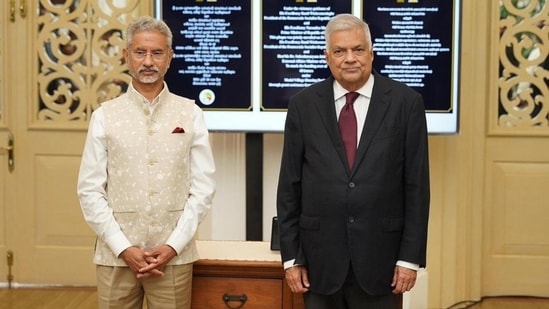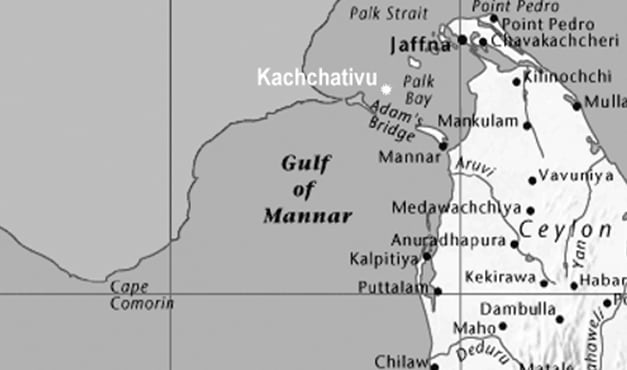Bridge that could boost India and Sri Lanka ties
This article is authored by Adluri Subramanyam Raju.
Historically, India and Sri Lanka have shared robust ties through cultural exchanges, human connections and trade. Both nations harboured favourable opinions of each other. However, recent years have seen strains in their relationship due to China's growing influence in Sri Lanka through investments and economic dominance. Sri Lanka is known as the "teardrop of India" for its shape and proximity, it is only 30 km from India's southernmost tip. The maritime boundary between India and Sri Lanka is divided at three points: The Bay of Bengal in the north, the Palk Strait in the middle, and the Gulf of Mannar in the south. The Palk Strait is the narrowest point, with a maximum distance of 45 km and a minimum of 16 km between Dhanushkodi in India and Talaimannar in Sri Lanka. In this region, both countries share rights over 12-22 km of water (yet no exclusive economic zone), with extensive coastlines along the Bay of Bengal and the Gulf of Mannar.

Building upon their longstanding agreements on maritime boundaries and the resolution of territorial disputes, India and Sri Lanka should embark on a transformative endeavour: the construction of the Palk Strait Bridge. This visionary project not only promises enhanced connectivity but also symbolises a renewed commitment to cooperation and economic integration between the two nations.
In July 2002, the then Sri Lankan government proposed a land bridge between Rameswaram in Tamil Nadu, India and Talaimannar in Sri Lanka, and signed an agreement on the same. According to this agreement, road and rail bridge links would be developed which would offer huge economic benefits to both sides of the Palk Straits. However, after the agreement was signed, the then Tamil Nadu government had opposed the construction of the land bridge. The then chief minister of Tamil Nadu, Ms J Jayalalithaa argued that the issue must be viewed not only from the economic point, but also from the security of India and Sri Lanka. She felt that the Liberation Tigers of Tamil Eelam (LTTE) would bring in “gun culture and worse still the horror of suicide bombing” into the peaceful state of Tamil Nadu. She felt that the proposed idea of the bridge is premature and unwise. The Tamil Nadu government’s apprehensions about the security of Tamil Nadu may be unfounded as it is not difficult to prevent the activities of LTTE crossing into the Indian territory. It would not be difficult for the Indian security agencies to prevent the LTTE guerrillas and sympathisers crossing into India. However, the civil war had ended, it is time to move forward.
Once the bridge materialises, movement of people and cargo is expected to surge increasing economic opportunities for both. It would reduce travel time and cost of movement of goods and services and facilitates trade in South Asian region. It also enhances the capacity of the Trincomalee port in addition to that of Colombo port. The Bureau of Investigation of Sri Lanka prepared a detailed study and proposed for a six-lane combination of bridges, causeways and rail tracks. It was reported that the depth of water does not exceed seven at any point.

The bridge could become a connecting link between the national highways in Southern India and those in Sri Lanka. It would facilitate a continuous road and ferry link from Madurai to Trincomalee and other major cities from both sides for cargo and passengers. The bridge would offer linkage to industries, especially agro-industries in South India and Sri Lanka. It would also carry transmission lines to hook up Sri Lanka to India’s Southern region’s electricity grid with the Kudankulam nuclear power plant serving as a base load station. If this is successful, the electric grid can be stretched from Nepal, Bhutan to Sri Lanka. It is reported that a firm NEXANT carried out a study on the feasibility of a 30-kilometre submerged High-Voltage Direct Current (HVDC) link through the Palk Strait between the countries for the exports of 500 megawatt to Sri Lanka. There are about 100 Indian companies invested in natural gas and oil, shipping, etc. in Sri Lanka. Through greater connectivity and cooperation, both can offer greater economic opportunities to each other and build a more comprehensive commercial environment.

In 2023, Prime Minister Narendra Modi and Sri Lankan President Ranil Wickremesinghe held “productive and outcome-oriented talks” at Hyderabad House, New Delhi, after which both the nations signed four agreements, including one to make the Sri Lankan port of Trincomalee a regional hub for industry and energy. The two sides also agreed upon boosting economic ties and connectivity including proposed connection of power grids and conducting feasibility studies on a possible petrol pipeline from southern India to Sri Lanka as well as a land bridge connecting the two nations to provide access to Trincomalee and Colombo ports. In April 2024, both the countries began a joint work to establish a land bridge. The need for this sea bridge has been part of discussions for more than a decade for the Modi-led National Democratic Alliance government.
India must play a constructive role as it is emerging as one of the major economies transcending from South Asia to the world. Further, the bridge also unveils the potential for tourism that can benefit the livelihood of many in Sri Lanka and India. Connectivity also creates prosperity that is intertwined with development and employment. The bridge can be a catalyst in forging brotherhood between Tamils on both sides, civil societies and both the governments.
Bridge connecting between Sri Lanka and India is an example to partner with other South Asian nations in development cooperation. Before much time is lost, India has to take initiatives and begin dialogue with others also on similar line.
India had emphasised the significance of connectivity as “both the driver and an outcome of economic growth” and the country should develop “connectivity across digital, physical, energy and human dimensions.” A year later, India proved to have tread on the same line, be it through the materialisation of Bharatmala project or the Kaladan Multimodal Project. Further, the bridge through Palk Strait promises to transform India-Sri Lanka relations, forges an unprecedented link between them. This ambitious project is more than just an engineering marvel; it symbolises a new era of connectivity, cooperation and cultural exchange in South Asia.
This article is authored by Adluri Subramanyam Raju, professor and head, Centre for South Asian Studies and UGC Centre for Maritime Studies, Pondicherry University.





